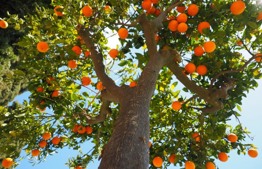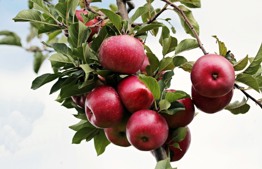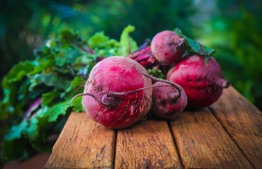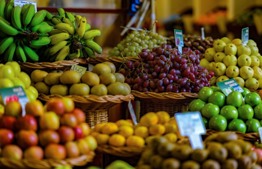Orlah, Chapter 6: Laws of Potted Saplings – Orlah and Nurseries
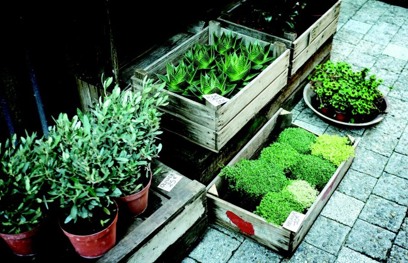
Laws of orlah as they relate to nurseries and unperforated pots. In which conditions can the orlah count continue for trees growing in nurseries?
- Unperforated pots and orlah[1]
- The obligation of orlah begins at the moment a fruit tree seed or sapling is sown or planted in the ground, as the verse states: "When you come to the land and you plant" (Vayikra 19:23). If the tree is planted in clod of earth in a pot with a perforated of at least 2.5 cm–provided that there is no barrier separating between the pot and the soil—the tree is considered planted in the soil.[2]
- Even if the tree is elevated above the soil, and there is no barrier separating between the perforation at the bottom of the pot and the soil, the tree is still considered planted in the ground.[3]
- If there is a surface that separates between the growing platform inside the pot (soil, sand, etc.) and the ground, the pot is considered an atzitz she-eino nakkuv, an unperforated pot. Unperforated pots are rabbinically subject to the laws of [4] Examples include fruit trees planted in a pot set on a porch; also fruit trees in nurseries in pots sitting on plastic sheets and wooden or stone surfaces. Even if there is a perforation in these pots, they are all considered to be unperforated pots for orlah purposes. After the orlah years are completed for such trees, the fruit is permitted. However, if transplanted to the garden or otherwise planted in the ground, the orlah count begins afresh. This is because the moment the tree is planted in the ground, the obligation of orlah becomes biblical.[5]
- A fruit tree planted on the roof of a house (or penthouse), or even on the patio inside the house, it is subject to orlah [6] However, if the tree is planted in a pot sitting on the floor of the house it is considered to be on a surface that disconnects the tree from the soil (an unperforated pot), and it is subject to orlah rabbinically, as we saw above.[7]
- Hydroponics and aeroponics
- It seems that hydroponically cultivated trees are subject to orlah[8]
- Aeroponics is a relatively new method of cultivation; poskim have not as yet directly addressed the issue of orlah with aeroponically cultivated trees or bushes (which are trees for halachic purposes, such as the blueberry bush).[9]
- Transplanting trees from a nursery
- As mentioned above, when transplanting a tree that was planted in the ground, the orlah count starts anew—unless the tree is transferred together with its clod of earth large enough to sustain it for two weeks (See Chapter 5, Section A).
- Today, people who want to plant fruit trees buy them in nurseries. Some of these nurseries also prepare the saplings. They produce the sapling from seedlings, through vegetative propagation (cuttings), or through tissue culture propagation. After producing the sapling (the rootstock), a graft is performed, and the grafted sapling is planted in a plastic bag that contains growing platform (generally 5–6 L of soil, sand, tuff, and various mixtures).
- The sapling generally stays in the nursery for more than a year until it is ready to be sold. The bags the saplings are sold with are generally large enough to sustain them.[10]
- If the sapling was transferred from the nursery into the house (while meeting the conditions listed below in Section D), there is no need to restart the orlah This is because in both places, the sapling is considered planted in an unperforated pot.
- Conditions for continuing the orlah count
- In order to continue the orlah count from the time the sapling was first produced in the nursery, the following four conditions need to be met:
- The bag the sapling is in sat on the ground and not on a surface separating it from the ground for the entire period it is in the nursery.
- There is a perforation at the bottom of the bottom of the bag holding the sapling.
- The sapling comes together with a clod of earth that can sustain it.
- The clod of earth surrounding the roots of the sapling did not crumble while transplanting it.
If not all of these conditions are met—even if there is uncertainty about any one of the conditions—the orlah count is restarted upon transplanting the sapling.
- When transplanting the sapling from the nursery, while fulfilling the conditions mentioned above: if a small part from the clod of earth crumbles (until approximately 30%), it is possible to count orlah years from the time the sapling was produced in the nursery. However, if a large part of this clod of earth crumbles, the orlah year count begins from the time the tree is transplanted.[11]
- The bag holding the clods of earth is considered a perforated pot as long as it has a perforation the diameter of at least 2.5 cm at the bottom of the bag, as mentioned above.[12] If the perforation is smaller than 2.5 cm, a competent Rabbi should be consulted (every case should be considered on an individual basis).[13]
- From the time the sapling is produced until it is planted (in an orchard, in the garden, etc.), this bag should be sitting on the ground and not on an elevated surface separating it from the ground. However, it is possible to transfer the saplings from the nursery to the orchard in a truck, even though they will be a separation between the sapling and the ground during that time. This is because the separation is only for a short period of time.[14]
- As mentioned above, if the sapling is sitting in the nursery on a sheet or other surface that separates it from the soil—even though the bag is perforated, orlah years are counted only from the time the trees are transplanted in an orchard or garden. Examples of surfaces that separate tree from the soil include: asphalt, concrete, wood, plastic, etc.
- Porous Palrig sheets (when there is only one layer and it is not lined by polyethylene, and water can penetrate it) does not serve as a barrier separating trees from the ground. When saplings are sitting on this surface, there is no need to restart the orlah count upon transplant.[15] If the Palrig sheet is composed of two layers—one layer of impermeable nylon and an addition layer of porous Palrig, it serves as a barrier between the sapling and the ground, and the orlah count should be restarted upon transplant.
- Trees planted in a clod of earth in a porous Palrig bag that only has small perforations but not a perforation of at least a 2.5 cm diameter – even if sitting directly on the soil, the orlah year count begins upon transplant in the orchard or garden. In this case, the sapling's nursery years cannot be counted.[16] However, if they are kept in the same place for a long time and the tree's roots penetrated through the bag into the soil, it would be possible to continue the orlah In this case, the orlah count would begin from time there are sufficient roots in the soil that can sustain the tree for two weeks.[17]
- There are nurseries that do not produce the saplings, but rather sell private consumers saplings produced elsewhere. When purchasing sapling from such nurseries there is no way to know whether the sapling sat on the ground the entire time. For this reason, we are stringent and restart the orlah count from the time the tree is transplanted in the orchard or garden. Of course, unless the nursery that we purchase the sapling from as well as the nursery that originally produced it are under halachic supervision.
Note that most nurseries prefer to store their saplings on a surface that detaches them from the ground so that they do not take root in the soil. This obviates the need to cut the sapling's roots when bought so as to avoid both shocking the tree and the physical labor involved in cutting the roots. In truth, even if at the time the tree is purchased, it sits directly on the ground, there is no way to know that this was the case even a week beforehand. For these and additional reasons, the basic assumption is that we cannot rely on the years in the nursery for the orlah count—unless the nursery is under hala
[1] An in-depth article on this topic, see Rabbi Azriel Ariel, "The laws of orlah for nurseries," HaTorah VeHa'aretz I (5749), pp. 189–244.
[2] Many halachic sources consider planting a sapling in a perforated pot as if it is being planted in the ground. See Mishnah, Shabbat 10:6.
[3] HaTorah VeHa'aretz I (ibid.), pp. 219–222.
[4] See Rambam, Hichot Ma'aser Sheni 10:8 and Shulchan Aruch, YD §294:26 that even a tree that grows in an unperforated pot is subject to orlah. The Yerushalmi, Orlah 1:2, explains that the reason for this is that "השורשין מפעפעין אותו," the roots penetrate it". According to the Yerushalmi, it seems that when the roots are not receiving nourishment from the soil or penetrating through the walls of the pot, the tree is exempt from orlah. This opinion is cited by Rabbi Shlomo Zalman Auerbach, Minchat Shlomo I §70; and Rabbi Shaul Yisraeli, "Halachic survey on orlah for saplings growing in unperforated pots," HaTorah VeHa'aretz I (5749), pp. 133–147. See also Chazon Ish, Dinei Orlah §32, where he writes (regarding metal pots) that these trees are subject to orlah rabbinically. This opinion seems to be the mainstream opinion. Note that Rabbi Ovadia Yossef (Miperi Ha'aretz III, p. 60, 5741) holds that trees in unperforated pots are subject to orlah biblically. See also Rabbi Yehuda Amichay, "Orlah for saplings sitting on Palrig sheets," HaTorah VeHa'artez V (5760), pp. 88–92.
[5] For an in-depth discussion on the topic, see Minchat Shlomo, ibid.
[6] Responsa Rosh §2:4; Shulchan Aruch, YD §294: 26; HaTorah VeHa'aretz I (ibid.), pp. 231–232; Rabbi Yoel Friedemann, "What is a disconnected platform (matza menutak)," HaTorah VeHa'aretz VI (5761), pp. 340–359.
[7] Regarding the law cited by the Rosh, ibid., this case refers to when there is a layer of soil on the roof. In this case, this soil is considered the ground for all intents and purposes - karka olam (lit. the ground of the world"; that is, the soil is associated with ground-level soil even though it is on the roof); and everything growing there is considered as if it were growing in the ground. However, a perforated pot laying on the house's ceramic tiles cannot receive nourishment or be sustained from these tiles. This is also the conclusion of the Chazon Ish, Shevi'it §22:1, incipit uvien. See also HaTorah VeHa'aretz VI, ibid., especially pp. 349–354. Some maintain that as long as the pot was not placed onto a plastic plate, the floor is not considered a barrier, and so the tree is subject to orlah biblically. See Minchat Shlomo I §41:2. Rabbi Shlomo Zalman Auerbach, though, limits this to a house on the ground floor; if placed on the second floor (or higher), the tree is considered disconnected from the ground.
[8] Rabbi Yitzchak Yosef, Yalkut Yosef, Mitzvot Hateluyot Ba'aretz II–III, p. 161, forbids this outright.
[9] See Orlah, Chapter 3, n. 15: Rabbi Yaakov Ariel rules that aeroponically grown plants are exempt from terumot and ma'aserot (yet there are those who are stringent). It is unclear, however, if this exemption would extend to the laws of orlah for trees grown aeroponically.
[10] See Agron. Mordechai Shomron, "Solution to the problem of orlah in nurseries" HaTorah VeHa'aretz V (5760), pp. 69–71.
[11] Argon. Mordechai Shomron, "The orlah count for a clod of earth that crumbled," HaTorah VeHa'aretz V (5760), pp. 72–76.
[12] For the Chief Rabbinate guidelines, see HaTorah VeHa'aretz I (5749), pp. 242–244.
[13] See Mishnah Okzin 2:10; Orlah 1:4; Shabbat 95b; see also HaTorah VeHa'aretz I (ibid.), pp. 223–225, for the calculation of the perforation size. Each case should be addressed individually, since it depends on how long the bag sat in the same place. If the roots pushed through the perforation and rooted in the ground, the tree is considered connected to the ground.
[14] Rabbi Zvi Pesach Frank, Responsa Har Zvi Zeraim II §14; Chazon Ish, Orlah §2:13, Dinei Orlah §32; Minchat Shlomo II §70:5, p. 464; Rabbi Shaul Yisralei, "On transplanting saplings and the effect on the orlah count" Barkai I (5743), p. 90; HaTorah VeHa'aretz I (ibid.), pp. 236–241.
[15] Rabbi Yehuda Amichay, " Orlah with saplings set on Palrig sheets," HaTorah VeHa'artez V (5760), pp. 88–96; optimally the orlah count should begin four months after the sapling is placed on a Palrig sheet, since that is the time it takes for the roots to penetrate through the sheet. See Rabbi Yoel Friedemann, "Orlah for saplings set on Palrig sheets," HaTorah VeHa'aretz V (5760), pp. 97–103. Note that the guidelines of the Chief Rabbinate of Israel (in Commercial Saplings), consider Palrig sheets a barrier, and note that saplings should not be placed on them if the sapling's years are to be included in the orlah count.
[16] Responsa Minchat Yitzchak VIII §92:2; see also the approbation by Rabbi Shlomo Zalman Auerbach in the beginning of Ha'aretz VaMitzvoteha (5748) by Rabbi Goldberg. See also HaTorah VeHa'aretz I (ibid.), pp. 227–228.
[17] Mishpat Kohen §8; Chazon Ish, Orlah, §2:12, incipit veacharei; HaTorah VeHa'aretz V (ibid.), pp. 99–100.

